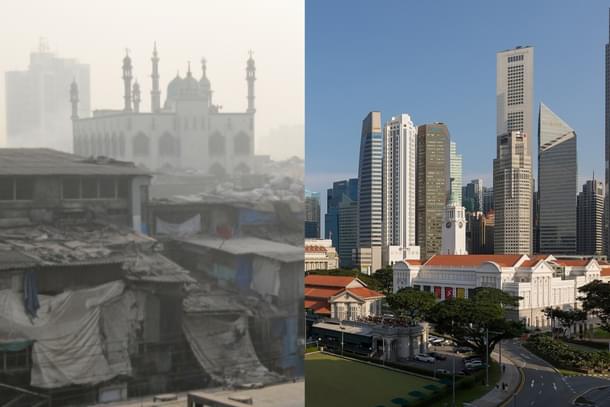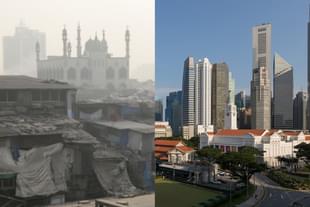Ideas
The 'Muslim Area' Problem: Why India Cannot Copy-Paste Singapore's Ethnic Integration Policy
Arush Tandon
Oct 20, 2024, 11:37 AM | Updated Nov 13, 2024, 02:33 PM IST
Save & read from anywhere!
Bookmark stories for easy access on any device or the Swarajya app.


Recent incidents of Islamist violence in India have brought the phenomenon of ‘Muslim areas’ back into focus. These are areas in cities and towns where the majority residents belong to the largest minority community.
Any non-Muslim event or celebration in these areas is discouraged, lest it ‘offend’ the residents. The rule of law is assumed to operate in a watered-down version in these zones. Unfortunately, such an explanation for blatant Islamist violence and assertion is increasingly being normalised in both government and non-government thinking.
One of the many answers to solve this problem include implementing the ‘Singapore model’ in Indian urban spaces. Specifically, their ‘Ethnic Integration Policy’.
What is Singapore’s ‘Ethnic Integration Policy’?
The Ethnic Integration Policy or the EIP aims to prevent the formation of ethnic enclaves in government housing estates.
It does this by imposing limits on the number of households of each race within individual neighborhoods and housing blocks.The main ethnic races in Singapore are the Chinese, Malay, and Indian (among others). The policy’s objective is to prevent communal clustering/ethnic concentration of any one race in a neighbourhood or even a housing block in Singapore. The policy has been in effect since 1989.
As per this piece in Straits Times: “The last time ethnic limits were publicly updated was in 2010. At the neighbourhood level, the quotas were 84 per cent for Chinese, 22 per cent for Malays, and 12 per cent for Indians and other ethnic minority groups.
“At the block level, the limits were 87 per cent for Chinese, 25 per cent for Malays, and 15 per cent for Indians and others.”
This implies that in any neighbourhood, no more than 84 per cent of households could be occupied by Singaporeans of Chinese descent; no more than 22 per cent by those of Malaysian descent; and no more than 12 per cent by those of Indian descent.
Singapore is heralded for its economic growth and prosperity. One of the reasons cited for that is the way the Singapore government has managed social stability and ethnic integration in the country. The EIP is a major instrument in that regard.
Can India replicate EIP?
In this writer’s view, no. All things considered and remaining the same, India cannot replicate Singapore’s EIP. The remainder of this piece would be used for answering why.
For better comparison and for removing the issue of scale, let us not compare India with Singapore but let’s say, Lucknow with the East Asian country.
Both have comparable population—58 lakh in Singapore and a little above 40 lakh in Lucknow—and comparable areas—631 sq.km. for Lucknow and around 700 sq.km. for Singapore.
Here, then, are seven reasons why Lucknow cannot implement Singapore’s Ethnic Integration Policy:
1. Can’t pick and choose across cultures
The first reason is that you cannot pick and choose traits/qualities/practices from across societies a third of the way across the globe. If you want one quality from another society, it has come as part of a wholesale import of that culture.
Want punctuality, cleanliness, and quality of Japanese transport? You will have to be punctual with everything else and elevate mundane activities of life to a ritual at a mass scale–like the Japanese.
Want the state-driven ethnic integration of Singapore? You will have to be like Singapore in all other respects.
Singapore has near-zero levels of corruption and the breach of law is truly an exception in the country. If Lucknow has to implement Singapore’s EIP, it has to be like Singapore in all other aspects of governance, and Lucknow’s residents have to be equally law-abiding.
You cannot have Singapore’s ethnic integration with the municipal governance and public attitude towards the law of Lucknow. It’s either wholesale import or nothing at all.
2. Inability to define communities
Singapore recognises three primary ethnic groups: Chinese, Malay, Indian. Other ethnicities are counted along with ‘Indian’ when it comes to the EIP.
How many groups would you recognise in Lucknow, based on what criteria?
Let’s say there are two groups:
Hindus and other Indian-origin faiths
Muslims, Christians and others
Would Muslims be comfortable in being slotted with Christians in the name of ethnic integration? Further, would Ashraf Muslims be comfortable in being counted in the same category as Arzal and Ajlaf Muslims.
Would various castes and sub-castes of Hindus be comfortable in being slotted with one another under the same title, leave alone being counted in the same group as Sikhs and Buddhists?
Singapore government’s policies outside of housing as well recognise only three main ethnic groups. This solidifies these ethnic identities in the minds of the citizens and prevents sub-identities from rearing their head.
In Lucknow, Shia-Sunni friction is more common than Hindu-Muslim conflict at the level of the street. On the other hand, near the peak of political power, competition between various Hindu castes is commonplace. Hence, if Lucknow has to implement the EIP, its own residents first have to agree on a clear hierarchy of identities.
3. Reliable data?
The first requirement for a government programme/policy, before even the level of formulation, is the availability of reliable and verified data. While the quality of citizens’ data is of course more reliable in Singapore, a city like Lucknow doesn’t even officially know how many of its residents are bonafide citizens of India and how many are illegal intruders. Formulating and implementing a policy like EIP in the absence of basic data is certain to back-fire.
4. Power of real estate
EIP means the government directly intervening in the real estate market and determining who can buy and sell property.
In Singapore, the real estate lobby cannot bring down the government. In case they feel their interests are in jeopardy, they can lobby and make impassioned representations to the government, but they are unlikely to have the power to effect a change in government itself.
In Lucknow, if real estate interests feel that a government policy will result in their losses, they are more than likely to have the policy reserved, or in the worst case, have the government itself changed.
Real estate is a source of corruption for virtually every government department in Lucknow. Any fundamental change in real estate policy will face the combined inertia of all these departments. That is an obstacle almost entirely absent in Singapore.
5. Number of people dependent on government for housing
A policy like the EIP would be easier to implement in a country like Singapore where more than 80 per cent of residents live in public housing. Lucknow would have two problems in this regard:
–The proportion of people living in government-owned housing would be far lesser.
–Even this number would be unclear in the absence of verifiable and reliable data.
6. Trust in the government to do the right thing
In Singapore, there is a high probability that an average citizen would trust the government to implement the EIP fairly and uniformly throughout the country.
The expectation that high-quality civic amenities and security would be provided in government-owned neighbourhoods, blocks, apartment complexes is a given. If any neighbour steps outside the boundaries of law, the government will more often than not take quick corrective measures.
All of this makes the implementation of the Ethnic Integration Policy that much easier. The transparent and effective working of the state and the citizens’ trust that the state would work transparently and effectively.
That is why complaints against the EIP in Singapore are minimal. The government is virtually deciding where a citizen would stay and by and large, the citizenry does not have a problem with it.
That trust is minimal in India. This writer would not even entrust the government of his favoured party with that privilege.
In another scenario, if an erring neighbour belongs to a community favoured by the party in power, then you would be paying the cost of an EIP while all the benefits would accrue solely to the neighbour.
7. Political continuity
Far-reaching policies like ethnic integration have a long gestation period. Secondly, they can easily be reversed if a political dispensation not favoured to it comes into power. Political stability and continuity is sine qua non for a policy like the EIP.
Singapore has had the same party in power since 1959. On the other hand, Yogi Adityanath is the first chief minister of Uttar Pradesh to be re-elected after serving a full five-year term. The difference in political stability between Lucknow and Singapore is made plain by that one comparison.
The purpose of this piece is not to induce cynicism regarding Indian governance and government. It is to argue that the problem of minority ghettos being an area where law and order stands ‘suspended’ is an Indian problem and its solution would have to be indigenously Indian.
And even if ethnic integration has to be implemented in India at any scale, there are far more fundamental problems that both government and society have to solve for first.





